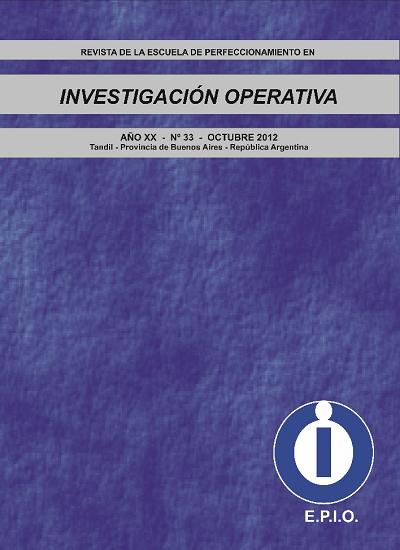Statistical and connectionist models for predict the academic performance of universitary students
Keywords:
academic performance, university freshmen, multinomial logistic regression, neural networks, multilayer perceptron, radial basis functionAbstract
This paper analyzes the relationship between the academic performance of students entering professional profile's careers in the FACENA - UNNE in Corrientes, Argentina, during the first year, and their social-educational characteristics.
Performance was measured by the approval of the partial evaluation of the subjects in the first semester of the first year. A model of Multinomial Logistic Regression (MLR) and two models of neural networks of type Multilayer Perceptron (MP) and Radial Basis Function (RBF) were fitted to two data sets: a) students entering in Biochemistry, whose curriculum includes two subjects in the first semester of the first year, b) students entering careers whose curriculum includes three subjects in the first semester of the first year.
In both cases, the PM model produced the best fit, and besides it was observed that in the case b) the three techniques showed high percentages of correct classification. The obtained results contribute to guide policies and strategies to improve the worrying levels of dropout and low performance of students in the first year of college.
Downloads
References
• AGRESTI, A. (1996): “AN INTRODUCTION TO CATEGORICAL DATA ANALYSIS”. New York: Wilely.
• BISHOP, C. (1995): “NEURAL NETWORKS FOR PATTERN RECOGNITION”. Oxford: University Press. En: LÉVY MANGIN, J.; VARELA MALLOU, J. (2003): “ANÁLISIS MULTIVARIABLE PARA LAS CIENCIAS SOCIALES”. Pearson Educación S. A.
• BORRACCI, R. A. y ARRIBALZAGA, E. B. (2005): “APLICACIÓN DE ANÁLISIS DE CONGLOMERADOS Y REDES NEURONALES ARTIFICIALES PARA LA CLASIFICACIÓN Y SELECCIÓN DE CANDIDATOS A RESIDENCIAS MÉDICAS”. Educación Médica Vol 8 Nº 1. ISSN 1575-1813. Barcelona.
• BROOMHEAD, D.S.; LOWE, D. (1988): “MULTIVARIABLE FUNCTIONAL INTERPOLATION AND ADAPTIVE NETWORK”. Complex Systems, 2, 321–355.
• CASTILLO, E.; COBO, A.; GUTIÉRREZ, J.M.; PRUNEDA, R.E. (1999). Introducción a las Redes Funcionales con Aplicaciones. Un Nuevo Paradigma Neuronal”. Editorial Paraninfo S.A. Madrid. España. pp.5-8; 8-16; 21-24, 30-34, 53-100.
• CHERKASSKY, V.; FRIEDMAN, J.H. Y WECHSLER, H. (1994): “FROM STATISTICS TO NEURAL NETWORKS”. Springer- Verlag. Berlin.
• COMISIÓN DE AUTOEVALUACIÓN FACENA-UNNE. (1996): “INFORME DE AVANCE PRE-DIAGNÓSTICO 1996”. Facultad de Ciencias Exactas y
Naturales y Agrimensura. Universidad Nacional del Nordeste.
• DAPOZO, G.; PORCEL, E. (2005): “METODOLOGÍA DE INTEGRACIÓN DE DATOS PARA APOYAR EL SEGUIMIENTO Y ANÁLISIS DEL RENDIMIENTO ACADÉMICO DE LOS ALUMNOS DE LA FACENA”. Comunicaciones Científicas y Tecnológicas de la Universidad Nacional del Nordeste 2005. Corrientes. Argentina. Disponible en: http://www.unne.edu.ar/Web/cyt/com2005/8-Exactas/E-032.pdf.
• DAPOZO, G.; PORCEL, E.; LÓPEZ, M. V.; BOGADO, V. (2007): “TÉCNICAS DE PREPROCESAMIENTO PARA MEJORAR LA CALIDAD DE LOS DATOS EN UN ESTUDIO DE CARACTERIZACIÓN DE INGRESANTES UNIVERSITARIOS”. IX Workshop de Investigadores en Ciencias de la Computación (WICC 2007). Trelew. Chubut. Argentina.
• FAUSETT, L. (1994): “FUNDAMENTALS OF NEURAL NETWORKS”. New York: Prentice Hall. En: LÉVY MANGIN, J.; VARELA MALLOU, J. (2003):
“ANÁLISIS MULTIVARIABLE PARA LAS CIENCIAS SOCIALES”. Pearson Educación S. A.
• FLEXER, A. (1995): “CONNECTIONIST AND STATISTICIANS, FRIENDS OR FOES?”. The Austrian Research Institute for Artificial Intelligence. Acceso FTP. Servidor: ai.univie.ac.at.
• GONZÁLEZ, D.S. (1999): “DETECCIÓN DE ALUMNOS DE RIESGO Y MEDICIÓN DE LA EFICIENCIA DE CENTROS ESCOLARES MEDIANTE REDES NEURONALES”. Biblioteca de Económicas y Empresariales. Servicios de Internet. Universidad Complutense de Madrid.
• HAYKIN, S. (1994): “NEURAL NETWORKS: A COMPREHENSIVE FOUNDATION”. New York: Macmillan Publishing. En: Lévy Mangin, J.; Varela Mallou, J. (2003). Análisis multivariable para las Ciencias Sociales. Pearson Educación S. A.
• HECTHT-NIELSEN, R. (1990): “NEUROCOMPUTING”. Addison-Wesley. Cal.
• HERTZ, J. KROGH, A. y PALMER, R. (1991): “INTRODUCTION TO THE THEORY OF NEURAL COMPUTATION”. Addison-Wesley. Cal.
• HILERA, J.R. y MARTÍNEZ, V.J. (1995): “REDES NEURONALES ARTIFICIALES: FUNDAMENTOS, MODELOS Y APLICACIONES”. Ra-ma. Madrid.
• HOSMER, D.; LEMESHOW, S. (2000): “APPLIED LOGISTIC REGRESSION. 2ND EDITION JOHN WILEY & SONS INC”. En: GARCÍA, T.; MONTERO, C.; RUÍZ, V.; VÁSQUEZ, M.; ÁLVAREZ, W. (2008): “APLICACIÓN DE LA REGRESIÓN LOGÍSTICA MULTINOMIAL EN LA DETECCIÓN DE FACTORES ECONÓMICOS QUE INFLUYEN LA PRODUCTIVIDAD DE LOS SECTORES INDUSTRIALES”. Ingeniería UC, Vol. 15, Núm. 3, pp. 19-24. ISSN 1316-6832. Universidad de Carabobo. Venezuela.
• HUNTER, A.; KENNEDY, L.; HENRY, J; FERGUSON, R.I. (2000): “APPLICATION OF NEURAL NETWORKS AND SENSITIVITY ANALYSIS TO IMPROVED PREDICTION OF TRAUMA SURVIVAL”. Computer Methods and Algorithms in Biomedicine 62, 11-19.
• LANZARINI, L. (2003): “REDES NEURONALES DE BASE RADIAL (EJEMPLO K-MEDIAS)”. Material didáctico. Cátedra “Redes Neuronales y algoritmos evolutivos”. Instituto de Investigación en Informática LIDI. Facultad de Informática. Universidad Nacional de La Plata. Buenos Aires. Argentina. Fecha de consulta: Abril de 2010. Disponible en: http://weblidi.info.unlp.edu.ar/catedras/neuronales/05_RBF.pdf
• MARTÍN, B. y SANZ, A. (1997): “REDES NEURONALES Y SISTEMAS BORROSOS”. Ra-ma. Madrid.
• MICHIE, D., SPIEGELHARTER, D.J. y TAYLOR, C.C. (1994): “MACHINE LEARNING, NEURAL AND STATISTICAL CLASSIFICATION”. Londres: Ellis Horwood.
• MOODY, J.; DARKEN, C. (1989): “FAST LEARNING IN NETWORKS OF LOCALLY TUNED PROCESSING UNITS”. Neural Computation, 1 (2), 281–294.
• PALACIOS BURGOS, F. J. (2003). “REDES NEURONALES CON GNU/LINUX COPYRIGHT (c)”- Herramientas en GNU/Linux para estudiantes universitarios- Capítulo 3. Tipos de Redes Neuronales. Fecha de consulta: Abril de 2010. Disponible en: http://softwarelibre.unsa.edu.ar/docs/descarga/2003/curso/htmls/redes_neuronales/x185.html
• PATTERSON, D. (1996): “ARTIFICIAL NEURAL NETWORKS”. Singapore: Prentice Hall. En: Lévy Mangin, J.; Varela Mallou, J. (2003). Análisis multivariable para las Ciencias Sociales. Pearson Educación S. A.
• PITARQUE, A.; RUIZ, J. C.; ROY, J. F. (2000): “LAS REDES NEURONALES COMO HERRAMIENTAS ESTADÍSTICAS NO PARAMÉTRICAS DE CLASIFICACIÓN”. Psicothema ISSN 0214 - 9915 CODEN PSOTEG. Vol. 12, Supl. nº 2, pp. 459-463. Disponible en: http://www.psicothema.com/psicothema.asp?id=604. 2000.
• POGGIO, T.; GIROSI, F. (1990): “NETWORK FOR APPROXIMATION AND LEARNING”. Proceedings of IEEE, 78 (9), 1491–1497.
• RIPLEY, B.D. (1996). “PATTERN RECOGNITION AND NEURAL NETWORKS”. Cambridge Univ. Press. Cambridge, G.B.
• RZEMPOLUCK, E. J. (1997): “NEURAL NETWORK DATA ANALYSIS USING SIMULNET”. Simon Fraser University. Burnaby. B.C. Canadá. ISBN: 0-387-98255-8. pp. 1-3, 13-75.
• SALGUEIRO, F.; COSTA, G.; CÁNEPA, S.; LAGE, F.; KRAUS, G.; FIGUEROA, N.; CATALDI, Z. (2006): “REDES NEURONALES PARA PREDECIR LA APTITUD DEL ALUMNO Y SUGERIR ACCIONES”. Workshop de Investigadores en Ciencias de la Computación 2006.
• SANTÍN GONZÁLEZ, D. (1999): “DETECCIÓN DE ALUMNOS DE RIESGO Y MEDICIÓN DE LA EFICIENCIA DE CENTROS ESCOLARES MEDIANTE REDES NEURONALES”. Disponible en: http://eprints.ucm.es/6674/1/9902.pdf.
• SARLE, W.S. (1994): “NEURAL NETWORKS AND STATISTICAL MODELS”. Proceedings of the 19th Annual SAS Group conference, Cary, NC. pps. 1538-1550.
• SHEPHERD, A. J. (1997): “SECOND-ORDER METHODS FOR NEURAL NETWORKS”. New York: Springer. En: Lévy Mangin, J.; Varela Mallou, J.
(2003). Análisis multivariable para las Ciencias Sociales. Pearson Educación S. A.
• VÉLEZ-LANGS, O.; STAFFETTI, E. (2007): “COMPUTACIÓN NEURONAL Y EVOLUTIVA. REDES DE FUNCIONES DE BASE RADIAL”. Material didáctico. Asignatura “Computación Neuronal y Evolutiva”. Escuela Superior de Ingeniería Informática. Universidad Rey Juan Carlos. Fecha de
consulta: Abril de 2010. Disponible en: http://www.ia.urjc.es/~ovelez/docencia/cne/Redes%20de%20Funciones%20de%20Base%20Radial.pdf
• WASSERMAN, P.D. (1989): “NEURAL COMPUTING: THEORY AND PRACTICE”. Van Nostrand Reinhold. N.Y.
• ZAMARRIPA TOPETE, J.; SÁNCHEZ RODRÍGUEZ, J. (2007): “PERFILES DE CALIDAD EN EVALUACIÓN INSTITUCIONAL Y PROGRAMA ACADÉMICO, APLICANDO REDES NEURONALES”. Anales del VII Congreso internacional “Retos y expectativas de la Universidad”. Junio de
Universidad Autónoma de Nuevo León. México. Disponible en: http://www.congresoretosyexpectativas.udg.mx/Congreso%201/Mesa%20E
/mesa-e_6.pdf. Fecha de consulta: Febrero de 2010.
Downloads
Published
How to Cite
Issue
Section
License
Atribución — Usted debe dar crédito de manera adecuada, brindar un enlace a la licencia, e indicar si se han realizado cambios. Puede hacerlo en cualquier forma razonable, pero no de forma tal que sugiera que usted o su uso tienen el apoyo de la licenciante.
NoComercial — Usted no puede hacer uso del material con propósitos comerciales.
CompartirIgual — Si remezcla, transforma o crea a partir del material, debe distribuir su contribución bajo la misma licencia del original.







